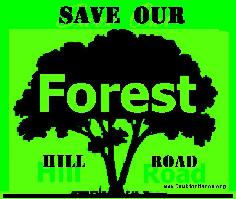
See Accident Data page here
See Road Profile Size analysis (here)
go back to Forest Hill Road
CAUTION Macon Macon-Bibb.com Moreland Altobelli

See Accident Data page here
See Road Profile Size analysis (here)
The Purpose
and Need for Forest Hill Road’s design is based on
traffic volume projections and safety concerns. This has been the
basis of the design from the first Purpose and Need written over a
decade ago until the latest (EA) Environmental Assessment revisions from
2007 and 2008. Unfortunately every EA for the project is based on
erroneous traffic projections, erroneous data used to make the
projections, and erroneous accident data and analysis. These
errors were created and compounded by Tom Moreland-Altobelli
contractors and sub-contractors.
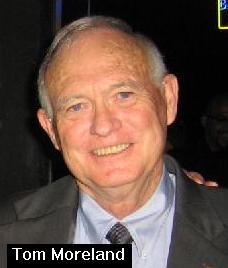
What is the
matter with Tom Moreland and his company Moreland-Altobelli,
Inc? (click)
.......
All traffic count data on this page was supplied
by the Georgia Dept of Transportation (GaDOT) .
Ga DOT provided this data set of Bibb County traffic counts
starting in 1983 :
http://www.macon-bibb.com/FHR/Traffic-Counts-2012.xls
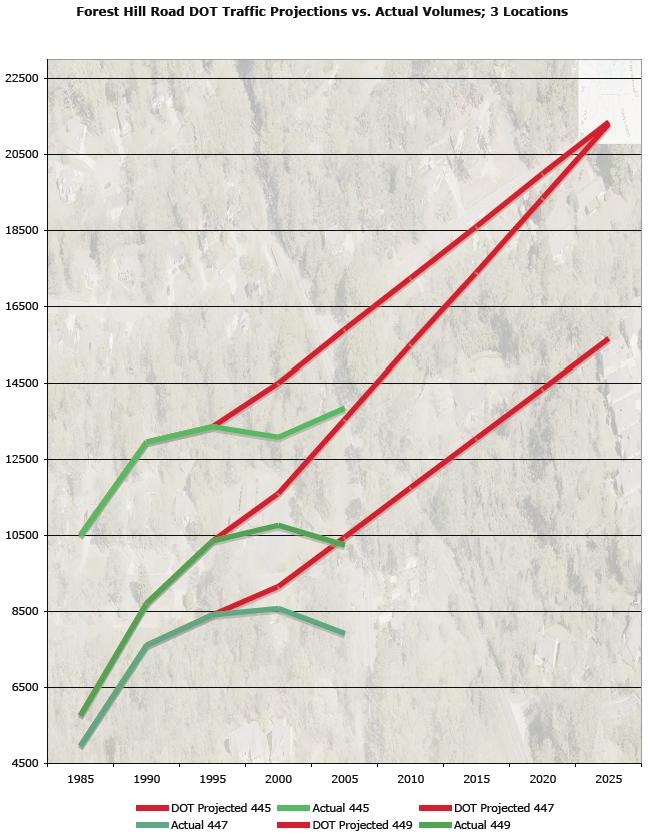
Traffic projections as presented
by Ga-DOT's subcontractor Moreland-Altobelli, Inc are grossly
inflated (RED above)
| |
||
| |
Excerpts
from Letter to
GDOT's attorney sent Friday, March 8, 2013 4 - Traffic Projections: Refer to webpage - http://www.macon-bibb.com/FHR/traffic.htm How does GDOT plan to defend its record of supremely inaccurate traffic projections in Bibb County? Refer to the case of Houston Road (Telegraph article 6-12-2005, posted on same page). Refer to the negative (reversed counts) projections for FHR since 2005. The database sampled in the chart below was emailed to me following a request at a MATS meeting at Macon-Bibb Planning and Zoning offices. http://www.macon-bibb.com/FHR/Traffic-Counts-2012.xls 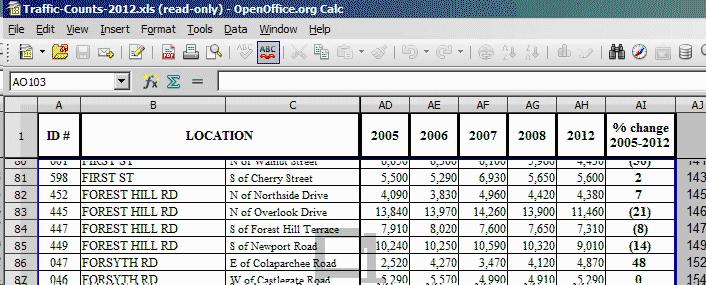 The section of FHR north of Northside Drive (the section that is Not in the Project Area) is the only section to grow in traffic volume - a minimal 7%. All other sections are down. The down sections are the sections in the Project Area. The Project Area traffic counts show a decrease in traffic from -21% to -8%. Why does this road with historically decreasing traffic counts need to be supersized? |
|
| Subject: RE: MATS 2040 LRTP From: Ken North <knorth@mbpz.org> I checked with Tri Vo at the Traffic Engineers Office and he said that GDOT did not do any traffic counts for Bibb Co. for 2009 thru 2011. --- Ken -----Original Message----- From: Holliday Dental [mailto:teeth@mindspring.com] Sent: Friday, March 08, 2013 3:06 PM |
||
Traffic_GDOT-Counts_2000-2012.pdf
See 2001 traffic count deceptions by GDOT (here)
|
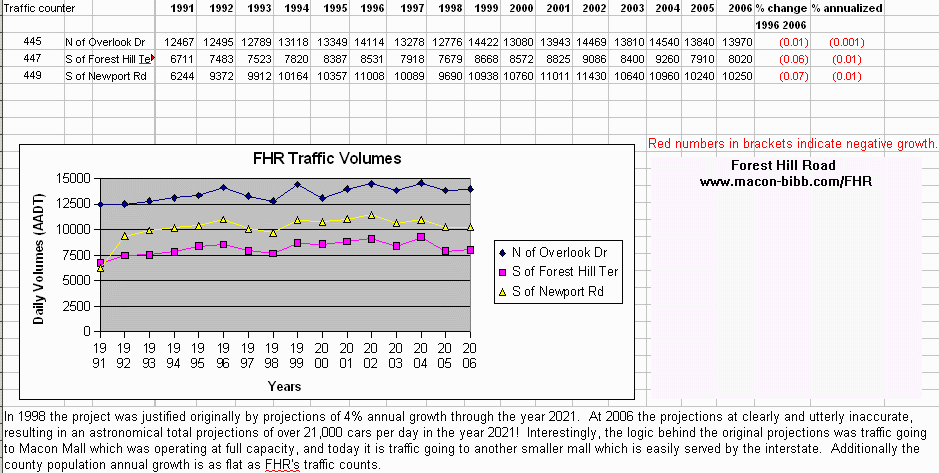
|
| database xls file of
above was prepared by - Tom Sholl |
| |
|
See 2001 traffic count deceptions by
GDOT (here) |
| 3 independent studies
that say the traffic volume projections are much, much
lower than Moreland's self-serving studies.
The 3 independent traffic studies were done by -
Chellman, Scholl, and the newest Macon Mall owners
(Augusta-based Hull Storey Gibson Cos). Chellman: http://www.macon-bibb.com/FHR/Forest_Hill_Road_Observations_Chellman.pdf http://www.macon-bibb.com/FHR/Forest_Hill_Road__Chellman_4-5-08.pdf Scholl: http://www.macon-bibb.com/FHR/FHR_Traffic-EA-Sholl_20100210.pdf Hull-Storey-Gibson Co: http://www.macon-bibb.com/FHR/Macon_Mall-Overbuilt_201009.htm |
|
Faulty traffic estimates fuel road debate |
|
Posted on Sun, Jun. 12, 2005 page 8A http://www.macon.com/mld/macon/11874848.htm
Faulty traffic estimates fuel road debate
Group says traffic counts used to justify widening were trumped-up; zoning officials say estimates 'unimportant'
By Travis Fain - Telegraph Staff Writer
When critics of the Forest Hill Road project argue that the planned three- and four-lane sections of the road will be overbuilt, they point south to five lanes of relatively sparsely traveled asphalt: Houston Road. Inflated traffic counts were used to justify the widening of Houston Road, according to members of CAUTION Macon, a roads watchdog group. Local planners dispute that, but acknowledge that since the decision was made to widen Houston Road, traffic projections have indeed gone down by as much as 10,000 cars a day - about half of the initial projection for the busiest stretch.
Critics are waiting for the same thing to happen on Forest Hill Road, which is scheduled to be widened in the coming years, in part because of future traffic projections. "The traffic counts were always wrong," said Lindsay Holliday, one of CAUTION's most vocal members and a recent candidate for the county commission chairmanship. "They let it slide."
Like the Forest Hill Road project, the widening of Houston Road was part of Bibb County's sales-tax-funded roads improvement program. On Jan. 7, 1999, the program's decision making body voted to widen Houston to five lanes, including a turn lane. Verbatim minutes of that executive committee meeting continually reference a report by Jim Evans, a private traffic consultant, that predicts between 20,600 and 24,100 cars a day will use the north end of Houston Road (north of Sardis Church Road) by 2025. The report concludes that 14,700 cars a day will use the southern portion of the road in 2025.
But a March 2003 report by the Macon-Bibb County Planning & Zoning Commission drops those projections to 9,430 to 14,480 cars a day for the north end and 6,000 to 11,660 cars for the south end of Houston Road. Evans has declined in the past to comment on why the new projections are lower than the ones he formulated, but did say he was confident of the higher numbers in 1999.
Planning and zoning officials, specifically commission director Vernon Ryle and planner Don Tussing, dismiss the difference as relatively unimportant. The Evans report, they say, was not used to justify the Houston Road widening. Instead, a 1998 report that predicts roughly the same traffic volumes as the March 2003 report was used, they said. What's more, the need to widen Houston Road had more to do with the number of curb cuts along the road - which correspond to turns and, therefore, potential rear-end collisions - than traffic volumes. But a transcript of the Jan. 7, 1999, executive committee meeting makes only passing references to curb cuts and safety, while traffic counts are mentioned repeatedly. Minutes from the technical advisory committee meeting held a month before also make no mention of curb cuts, but do reference traffic growth and Evans' report.
Congressman Jim Marshall, who was mayor of Macon in 1999 and sat on the executive committee, said the Evans traffic counts were the deciding factor on the road. "(The Evans report) basically was the reason (for the widening). ..." Marshall said. "The one reason offered for widening it was the traffic count. That was it. No other reason was offered."
Tussing has said he was never comfortable with the predictions in the Evans report. But during that January 1999 meeting Marshall specifically asked Ryle, who is Tussing's boss, if he had a problem with the Evans numbers.
"No," Ryle replied, according to minutes. Tussing was in that meeting, according to the minutes. "The Evans report was never used for anything than to verify what had already been done and when they came out higher, that was it," Tussing has said. "We moved on."
That was news to Marshall. "I personally recall no one in authority challenging or questioning the 24,000 projection. ..." Marshall said. "And I recall asking whether anyone had any doubt. The answer was no."
Tussing's projections for Forest Hill Road predict more than 27,000 cars a day will travel the road between Wimbish Road and Ridge Avenue in 2025. That's up from the 2002 count that found an average of about 14,000 cars traveled the road each day. "Forest Hill is approaching or at capacity now," Tussing said in an e-mail to The Telegraph. "Future growth will increase the traffic and only make things worse."
CAUTION members dismiss the projections, which member Tom Scholl called "as completely bogus as they were on Houston Road." Scholl and others have repeatedly asked that turn lanes be added to the road, but that it not be fully widened. The idea has been dismissed by Tussing and other planners who say you don't build roads for tomorrow, you build them for 20 years from tomorrow. Tussing cited commercial growth near the corridor, especially in the Interstate 75, Riverside Drive, Arkwright Road and Bass Road areas as the reason for the predicted traffic growth. He said just because the Evans numbers were high, that doesn't mean his are, too. Also, traffic projections aren't the only justification offered for widening Forest Hill Road. The two-lane road has curves that will be smoothed out. Turn lanes will be added, which should cut down on rear-end collisions because instead of braking in the travel lane, drivers can get into a center turn lane.
There have been 44 accidents on Forest Hill Road so far this year and most were rear-end collisions, according to Lt. Eric Woodford in the Macon Police Department's traffic division. "Traffic backs up from vehicles making left turns, widening the road will solve this problem," Woodford wrote in an e-mail to The Telegraph.
Side Box in printed version - but not online:
THE HOUSTON ROAD EXAMPLE:
Inflated traffic counts were used to justify the widening of Houston Road, according to members of a roads watchdog group. Critics are waiting for the same thing to happen on Forest Hill Road.
In 1999, Bibb County officials discussing the possible widening of Houston Road continually referenced the traffic count numbers from a report by a private consultant that predicted between 20,600 and 24,1000 cars a day would be using the north end of Houston Road (north of Sardis Church Road) by 2025.
But a 2003 report by the Macon-Bibb Planning and Zoning Commission drops those projections to 9,430 to 14,480 cars a day.
Zoning officials dismiss the difference
as relatively unimportant, and say the need to widen
Houston Road had more to do with the number of curb cuts
along the road than the traffic volumes.
Traffic (mis)Projections by Mr
Evans - Houston Rd Lawsuit - Walter Kulash saga
Comments by L Holliday in a letter to the Telegraph: I appreciate Travis Fain's Sunday article exposing the road planners misrepresentations of the traffic counts they used to justify Houston Rd and Forest Hill Road.
Most recently, the 2030 Long Range Transportation Plan summary misstated public support for widening FHR. In fact, the data in the manual itself showed 4/1 AGAINST widening. When I confronted Mr Ryle with this discrepancy, he made several excuses and indicated he had no intention of correcting the summary.
Planners continue to also misrepresent accident data, the effects of road geometry on speeding and noise, the destructive effects on adjacent neighborhoods, and the options for safer, less expensive, more efficient, traffic calming intersections such as roundabouts.
Vernon Ryle who is Executive Director for Planning and Zoning Commission recently showed his ignorance and obstinacy by demanding that I show him the studies that prove greater safety of roundabouts. Within hours I faxed and emailed him links to the US Federal Highways book "Roundabouts - An Informational Guide" which contains dozens of studies from the US and all over the globe.
These studies show "a reduction in crashes after building a roundabout of about 37 percent for all crashes and 51 percent for injury crashes in the US."
Bibb County and Macon should demand better performance from the P+Z Director. http://mbpz.org/administrative.html
|
|
Emails to Macon-Bibb officials about Forest Hill and Roundabouts Date: Sat, 05 Nov 2005 08:32:03 -0500 To: bwikle@co.bibb.ga.us,nfloyd@macon.ga.us From: Holliday Dental <teeth@mindspring.com> Subject: Roundabouts review in Carolina - can use info for Forest Hill Rd Cc: jack.ellis@macon.ga.us,mburns@mpd.bibb.ga.us,Katy.Allen@fhwa.dot.gov, vryle@mbpz.org,Kenneth Sheets <ksheets@co.bibb.ga.us>, Elmo Richardson <erichardson@co.bibb.ga.us>, Charlie Bishop <cbishop@co.bibb.ga.us>,mike.cranford@macon.ga.us
Dear Bill and Nigel, Thank you again for the time we spent on Oct 7th discussing the advantages of Roundabout intersections. Below is an interesting site that shows how North Carolina is moving ahead of Georgia with their intersection designs: http://www.ncdot.org/doh/operations/division14/roundabout/roundabout.htm I would like to learn what you may have found about the traffic counts at the Roundabout near Emory University at North Decatur and Lullwater Roads. My impression during a site visit there is - it carries more traffic more safely and more efficiently than the Forest Hill intersections. I plan to call you sometime next week. Thank you both, - Lindsay
Blind copies to Forest Hill Citizens: http://www.macon-bibb.com/FHR |
|
|
|
|
| " Georgia
Department of Transportation invents phantom public input.
And in other instances, particularly over Forest Hill
Road, traffic estimates are the stuff of Houdini." -
Telegraph Editors 6-8-03 (below) |
|
|
Posted on Sun, Jun. 08, 2003 - page
8.
http://www.macon.com/mld/telegraph/news/opinion/6032493.htm Roads should conform to community's wishes When citizens voted to approve a Special Purpose Local Option Sales Tax for road improvements on Nov. 8, 1994, it squeaked by. The winning margin was only 346 votes. Why? There was no question Bibb County needed a lot of road work. Streets were in ill-repair and traffic synchronization was nonexistent (still is). Over the five-year period of the SPLOST, it was estimated the additional penny tax would raise $100 million, and state and federal money would pump in another $200 million. After the vote, the NAACP threatened a suit charging that public monies were used to promote the tax and that the program ignored the needs of minority communities. The idea of a suit was dropped, but that was just the opening salvo in a long and contentious battle over the purpose of roads in Bibb County. Since 1995 when real work began, the program has hit a number of speed bumps, some small, some huge, not the least of which has been a band of what some call obstructionists: CAUTION Macon, Citizens Against Unnecessary Thoroughfares in Our Neighborhoods. CAUTION Macon organized in 1998. Its genesis was spawned by a perfect storm of events, starting with plans to widen Wesleyan Drive, Forest Hill Road and Edna Place. The elements that caused the group to form are still present today, mainly lack of communication, lack of trust and an arrogance by road leaders who discount public input. The program got off to a rocky start. There was haggling between the county and Georgia Power over who would pay for the movement of utility assets as the roads program progressed. Some neighborhoods, like Fort Hill, received new sidewalks burdened with power poles in the middle of them. Homeowners along the routes of some of the first projects were told only a small portion of their properties would be taken for road widening and sidewalks. However, once movement of utilities and other rights-of-way were factored in, those citizens watched as more of their property disappeared. And some of the first projects, particularly along Rocky Creek Road, were just unsightly. The community temperature was so high that CAUTION Macon was able to bring together segments of the community long separated by race and class to fight the program. Yellow ribbons and signs saying "Save our city" popped up like summer weeds after a thunderstorm. Instead of involving citizens in meaningful discussions, leaders were openly derisive when asked legitimate questions. Fast forward to present day and that small strip connecting Little Richard Penniman Parkway, called the Downtown Connector, and M.L. King Jr. Boulevard. Much of the citizens' wrath is due to broken past promises. The project is small in comparison to some, only $2.5 million, but leaders could not make a case for displacing long-time residents that made sense because they haven't dealt with issues facing the community beyond the new road. The other project is what has been called the Western Loop that starts at Bass Road and I-75 and winds its way to Eisenhower Parkway and Fulton Mill Road. People living along the loop's path have disliked just about every proposal, and now road engineers are getting set to present another plan. It is almost sure to be met with more opposition. So what's missing in this roads picture? A real honest community conversation about the quality of life in Bibb County, of which roads are only a part. It will take a deep cultural change in the roads programs on the state and local level if officials will ever see the day when their ideas aren't met with abject opposition. Road planners have taken the "My way or the highway" stance, and it has been unproductive. And it is with that type of heavy handedness that roads have been built in this state for decades. As in the recent uproar over I-75/I-16, the Georgia Department of Transportation invented phantom public input. And in other instances, particularly over Forest Hill Road, traffic estimates are the stuff of Houdini. [note: Harry Houdini died in 1926. As a metaphor "stuff of Houdini" is a bit dated. It means - magic, sleight of hand, tricks like "pulling a rabbit out of a hat", unreal, made-up, witchcraft, supernatural, see also shaman, counterspells, "Possessing distinctive qualities that produce unaccountable or baffling effects" - Answers.com. ] Leaders have attempted to divert opposition by employing the financing shell game that passes the highway buck between state, local and federal funding sources. When opposition arises, leaders throw up their hands and say it's a state or a federally funded project and they have no voice. Or, the mantra will go out that the entire project is at risk if opposition becomes too vocal. All the officials need to do is follow not only the letter of the law concerning public input, but its spirit. Those few voices still crying out for road justice should not be a nuisance. They have, in the final analysis, provided a valuable community service. Ultimately, roads are built to serve the people and the communities they run through. No matter how wide or expensive or safe, they will only be useful if they conform to the communities they serve, not the other way around.
See 2001 traffic count deceptions by GDOT (here)
|
|

|
| database xls file of
above was prepared by - Tom Sholl |
|
See 2001 traffic count deceptions by
GDOT (here)
|
Traffic (mis)ProjectionsMacon-Bibb RIP |
| Traffic (mis)Projections
by Mr Evans - Houston Rd Lawsuit - Walter Kulash saga James H. Evans, transportation engineer planner and consultant with PBS&J. http://www.macon-bibb.com/ROADS/Houston/jan7th.txt his testimony starts on page 146. Much related info is linked from http://www.macon-bibb.com/ROADS/Houston/H-road.htm including the Walter Kulash saga |
-
-
Forest
Hill
Road
-
-
is "...20% Safer than Ga Staewide Average..." - Harvey Keepler, Ga DOT Environmental/Location Engineer (summary here) or (entire 5 page letter) |
||
|
- CAUTION Macon - |
| |
go back to Forest Hill Road